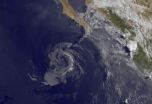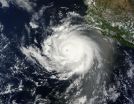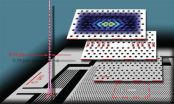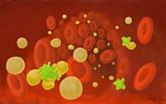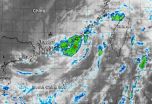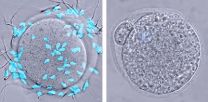(Press-News.org) An infrared image from NOAA's GOES-West satellite showed what appeared to be a ghostly ring of clouds and no convection in former Hurricane Cristina on Monday, June 16 as the system weakened to a remnant low pressure area.
Convection is rising air that forms the thunderstorms that make up a tropical cyclone and when there is none, there are no thunderstorms to keep it going. That's exactly what happened to Cristina in the Eastern Pacific Ocean on Sunday, June 15.
At 11 a.m. EDT (8 a.m. PDT) on Sunday, June 15, Cristina had weakened to a tropical depression near latitude 20.1 north and longitude 113.3 west, about 290 miles (470 km) southwest of the southern tip of Baja California At that time the depression was moving toward the west-northwest near 6 mph (9 kph) and Cristina's maximum sustained winds had decreased to near 35 mph (55 kph).Forecaster Brennan at the National Hurricane Center (NHC) noted that "Cristina continues to lack any deep convection, which is not surprising given the hostile environment of strong shear, cool waters and dry air."
That hostile environment took its toll on Cristina early on June 16 when the NHC declared Cristina a remnant low pressure area. At 09:07 UTC (5:07 a.m. EDT), the post-tropical remnant low pressure area formerly known as Cristina was centered near 21 north latitude and 115 west longitude. The remnant low had maximum sustained winds near 20 to 25 knots (23 to ~29 mph/37 to ~46 kph) and was generating seas to 8 feet (2.4 meters). As Cristina's remnants continue to dissipate, NHC forecasters expect wave heights to decrease.
INFORMATION:
Text credit: Rob Gutro
NASA's Goddard Space Flight Center
A satellite view: Former Hurricane Cristina now a ghost of its former self
2014-06-16
ELSE PRESS RELEASES FROM THIS DATE:
Trapping light: A long lifetime in a very small place
2014-06-16
Physicists at the University of Rochester have created a silicon nanocavity that allows light to be trapped longer than in other similarly-sized optical cavities. An innovative design approach, which mimics evolutionary biology, allowed them to achieve a 10-fold improvement on the performance of previous nanocavities.
In a paper published in Applied Physics Letters today and featured on the cover, the scientists demonstrate they have confined light in a nanocavity – a nanostructured region of a silicon wafer – for nanoseconds. Typically light would travel several meters ...
Broccoli sprout drink enhances detoxification of air pollutants in clinical trial in China
2014-06-16
A clinical trial involving nearly 300 Chinese men and women residing in one of China's most polluted regions found that daily consumption of a half cup of broccoli sprout beverage produced rapid, significant and sustained higher levels of excretion of benzene, a known human carcinogen, and acrolein, a lung irritant. Researchers from the Johns Hopkins Bloomberg School of Public Health, working with colleagues at several U.S. and Chinese institutions, used the broccoli sprout beverage to provide sulforaphane, a plant compound already demonstrated to have cancer preventive ...
Genetic influence on pulmonary function: Six further genes identified
2014-06-16
In their investigations or so-called genome-wide association studies, the team of researchers compared the genetic profile of study participants to the forced vital capacity (FVC), a volume parameter of lung function. Six gene loci here displayed a clear association with the FVC values. Involvement in lung development or certain pulmonary diseases is furthermore suspected for these genes.
Better understanding of the association between genes, lung function and lung diseases
The identified genes open up new molecular biological approaches for a better understanding of ...
Children in low-income homes do better in kindergarten if moms work when they are babies
2014-06-16
WASHINGTON - Kindergarteners from lower-income families who were babies when their mothers went to work outside the home fare as well as or even better than children who had stay-at-home moms, according to new research published by the American Psychological Association.
This finding, in a study published in APA's journal Developmental Psychology, is contrary to the findings of previous studies of children born two to three decades ago. Family income is apparently a key factor, with the new research finding children from low-income families had slightly higher cognitive ...
E-cigarettes far less harmful than cigarettes, says Lancet researcher at INFORMS Conference
2014-06-16
A London School of Economics researcher examining the public and private dangers of drugs argues against demonizing e-cigarettes in a presentation being given at a conference of the Institute for Operations Research and the Management Sciences (INFORMS). He also calls on public officials to recognize that alcohol causes greater harm than other recreational drugs and more public attention should be paid to controlling its harmful effects.
Lawrence D. Phillips, an emeritus professor at the London School of Economics, will present his research group's findings about the relative ...
Lipids help to fight leukemia
2014-06-16
T cells use a novel mechanism to fight leukemia. They may recognize unique lipids produced by cancer cells and kill tumor cells expressing these lipid molecules. A study conducted by researchers at the University of Basel shows that a tumor-associated lipid stimulates specific T cells, which efficiently kill leukemia cells both in vitro and in animal models. The results have been published in the Journal of Experimental Medicine.
Leukemias are cancer diseases affecting blood cells . Acute leukemias prevent development of normal bold cells and thereby are severe life-threatening ...
Cellular force that drives allergy and asthma can be blocked by interferon
2014-06-16
DALLAS – June 16, 2014 – A mechanism that could underlie the development of cells that drive asthma and allergies has been uncovered by immunology researchers at UT Southwestern Medical Center.
Asthma and allergies are both driven by an inappropriate activation of the immune system, primarily a subtype of white blood cells known as T helper 2 cells, or Th2 cells. These cells are normally responsible for defense against parasites, but are also the main culprits behind the symptoms of asthma and allergies.
Dr. David Farrar, Associate Professor of Immunology and Molecular ...
Studies in family planning publishes special issue on unmet need
2014-06-16
NEW YORK, NY (16 June 2014) — Studies in Family Planning, a leading journal published by the Population Council, released "Unmet Need for Family Planning"—a special issue featuring ten articles, including a comprehensive introduction to the topic of unmet need. Distinguished researchers explore trends related to unmet need for contraception, and many articles point to practical strategies for increasing contraceptive knowledge and uptake, and for overcoming barriers that prevent women from practicing contraception.
"Unmet need has been an important indicator for measuring ...
NASA catches short-lived tropical cyclone Hagibis landfalling in China
2014-06-16
Tropical storm Hagibis only lived through 6 bulletins issued by the Joint Typhoon Warning Center in its short lifetime in the northwestern Pacific Ocean. The final bulletin was issued on June 15 at 1500 UTC (11 a.m. EDT) after Hagibis made landfall in China.
Hagibis was born in the South China Sea on June 14 at 0900 UTC (5 a.m. EDT) near 20.7 north latitude and 117.0 east longitude, about 183 nautical miles east-southeast of Hong Kong when a low pressure system quickly consolidated and maximum sustained winds jumped to 35 knots (40 mph/62 kph). Hagibis is the seventh ...
How sperm get into the zona
2014-06-16
Before it can fertilize an egg, a sperm has to bind to and bore through an outer egg layer known as the zona pellucida. Despite decades of research, some of the biological mechanisms behind this process remain unclear. A study in The Journal of Cell Biology now identifies the protein in the zona pellucida that sperm latch onto.
The zona pellucida protects the egg and the early embryo before implantation. Its structure seems simple—in humans it contains four kinds of glycoproteins, and in mice it only contains three. But researchers haven't been able to identify the sperm's ...
